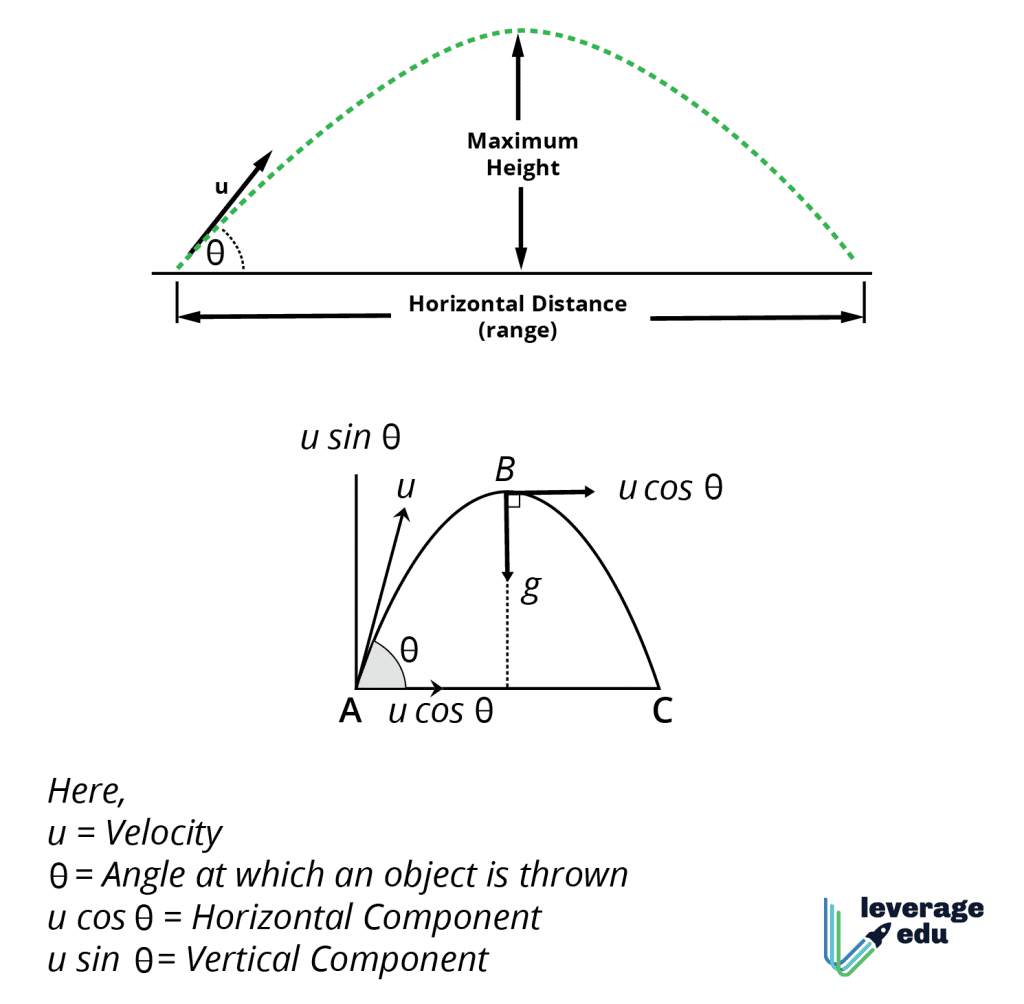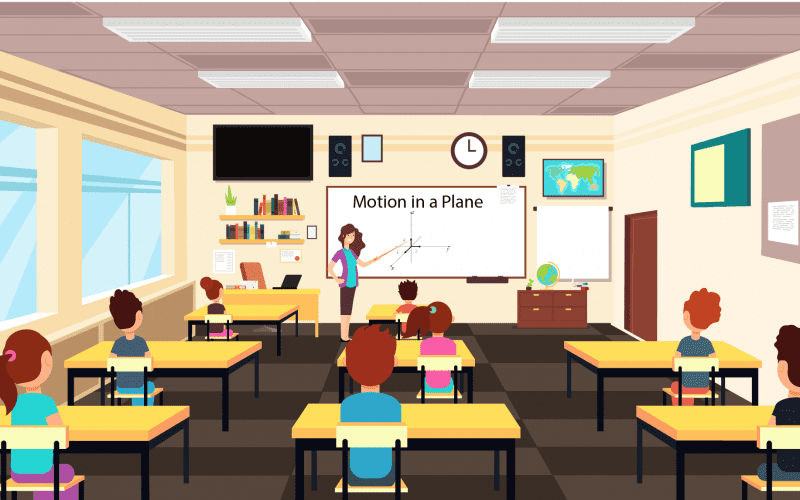An intriguing and one of the most important topics for various government exams after 12th Science, Motion in a plane, which forms an integral part of the Physics syllabus for class 11, covers the basics of 2-d kinematics in a detailed way. This knowledge ensures a better understanding of the topics further up in Physics. From throwing a ball over to your friend to a skydiver jumping out of a plane, this topic lets us analyze the day-to-day occurrences we observe around us. To provide a better understanding, we have summarised the essential details pertaining to this topic.
This Blog Includes:
What is Motion in a Plane?
Before we delve deep into the concepts pertaining to the motion in a plane, let us first understand what the term “Plane” denotes. The plane is nothing, but a flat surface that consists of 2 dimensions. Therefore, the motion that occurs in two dimensions is called Motion in a Plane. The plane is denoted by X- and Y-axis. This motion can be rotational, projectile or even relative in nature. To understand more, let us go through other essential concepts.
Click Here for Motion in a Plane Class 11 PDF
What are Vectors and their Basic Operations?
Vectors are entities with both magnitudes as well as directions. They are generally denoted by an arrow (→) along with their magnitude. Vectors are a seemingly new topic for class 11 Physics, and hence, we must have a better understanding of it. Vectors have basic operations such as vector addition, subtraction, multiplication, and resolution, however, these are different from the mathematical laws we have learned till now. This is because vectors contain directions as well. Hence, the resolution of vectors comes in handy in understanding the motion in a plane.
Types of Motions in a Plane
As discussed, there can be different types of motions that occur on a 2D surface. This can be Circular, Projectile, or Relative. The basic details related to types of motion in a plane have been given in a rundown below.
Projectile Motion
Whenever we kick a ball to our friend or throw a stone from a cliff, we are observing a type of Planar Motion known as Projectile Motion. In this type of motion, a ‘Projectile’ or an object is thrown at different angles, at different velocities and from different initial heights. This motion can easily be understood using horizontal and vertical components of motion, which are independent of each other.
- Horizontal Component: This consists of the horizontal motion of the projectile. On analysing this, we get results known as Range, Time Period, etc.
- Vertical Component: On carefully applying basic arithmetic to equations of motion, while only considering the vertical quantities of the motion, we get results such as Maximum Height, Velocity at any time, etc.
What is important to note is that if the object is thrown vertically upwards(uniform acceleration), we can determine its motion using the equation of motions. However, if the object is thrown at different angles, we take the horizontal as well as the vertical components of initial velocity into consideration. This can be explained using the image below.

Circular Motion
Unlike projectile motion, circular motion consists of the analysis of the motion of an object moving at the same distance relative to a fixed point, i.e., in a circular path. Again, this motion’s attributes can be broken down and understood clearly with the help of horizontal and vertical components of the motion of the object.
Relative Motion
Motion, where we take information according to a relative observer rather than a universal one, is called relative motion. When we consider the heights of two persons, we say that person A is 177 cm and person B is 180 cm tall, but when talking relatively, we say person A is 2 cm shorter than B or vice versa.
Terms Regarding Motion in a Plane
Now that you have got an overview of the basic concepts pertaining to different types of motion in a plane, let us understand some important terms in detail.
- Maximum Height: The maximum height is the altitude an object reaches during its entire interval of time portraying motion in a plane.
- Time Interval: This denotes the entire duration of time while the object was in motion.
- Horizontal Range: The total distance from the initial point of projection of an object to the final point in its journey is called its horizontal range.
- The Angle of Projection: It denotes the initial angle (from the horizontal plane) at which the object is projected.
- Angular Displacement: The angle covered by the initial and final points of an object during its circular motion. Its unit is in radians.
- Angular Velocity: This is the circular counterpart of velocity and is defined as the rate of change in angular displacement. Its unit is radian per second.
Motion in a Plane: Important Questions
The following are some questions required in order to have a firm grasp of concepts regarding motion in a plane.
- What is the angle of projection required in order to have maximum ‘horizontal range’?
- What are the conditions for the addition of 2 vectors?
- Can multiple vectors of the same magnitude be added to give the resultant as zero?
- Define ‘Scalar Product’ and ‘Vector Product’ and highlight key differences between them.
- If a storm is blowing in the horizontal direction in support of the object, with acceleration ‘a’, then what changes will there be in its Range and Maximum Height?
- A man on a moving truck throws a stone directly above him. Can he catch the stone? What should be the conditions for him to be able to catch the stone after throwing it??
- What is the maximum velocity with which a vehicle can turn on a circular turn on a road?? (Given- µ is the friction coefficient).
- A passenger wants to go from the station to a hotel located 10 km away on a straight road from the station. But the cab man takes him along a circuitous path 23 km long and reaches the hotel in 28 min. What is (a) the average speed of the taxi, (b) the magnitude of average velocity? Are the two equal?
- A woman rides a bicycle with a speed of 10 m s-1 in the north to south direction while rain is falling vertically with a speed of 30 m s-1. In which direction she should hold her umbrella ?
- A cricketer can throw a ball to a maximum horizontal distance of 100 m. How much high above the ground can the cricketer throw the same ball?
- A stone tied to the end of a string 80 cm long is whirled in a horizontal circle with a constant speed. If the stone makes 14 revolutions in 25 s, what is the magnitude and direction of acceleration of the stone?
- A cyclist is riding at a speed of 27 km/h. As he approaches a circular turn on the road of radius 80 m, he applies brakes and reduces his speed at the constant rate of 0.50 m/s every second. What is the magnitude and direction of the net acceleration of the cyclist on the circular turn?
Download the PDF for the Motion of a Plane from here.
FAQs
Ans. Motion in two dimensions, such as projectile motion, circular motion, etc., is referred to as motion in a plane. We will use an origin, two coordinate axes (X and Y), and such motion for the study. Quantities in scalar and vector form. Scalar Numbers
Ans. According to the nature of the movement, motion is classified into three types as follows:
Linear Motion.
Rotary Motion.
Oscillatory Motion.
Ans. Two-dimensional motion can refer to motion that occurs in a plane. Think about projectile motion and circular motion, for instance. Additionally, the two-dimensional relative motion will be covered.
Hence, developing a strong understanding of concepts related to motion in a plane is essential for scoring well not only at the 10+2 level but also in scores on competitive exams like JEE Advanced, SAT, etc. Exploring career options after 12th abroad? Not sure which university or country to kickstart your career in? Then take the assistance of the experts at Leverage Edu who will not only help you choose a university that aligns with your interest but will also guide you throughout the admission process!

 One app for all your study abroad needs
One app for all your study abroad needs





















 45,000+ students realised their study abroad dream with us. Take the first step today.
45,000+ students realised their study abroad dream with us. Take the first step today.

